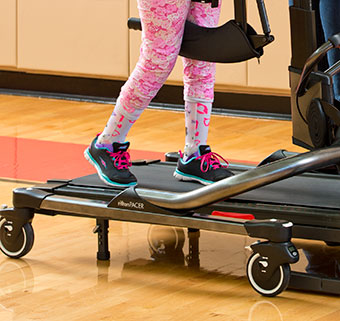Although integrated into pediatric clinical practice for the last decade, body weight supported treadmill training (BWSTT) continues to be an area of research interest and an evolving intervention. We can see this reflected in a recent study examining effective motor learning strategies for treadmill training.
 For children with disabilities, the treadmill is a safe place where they can organize their motor, cognitive and perceptual systems to the task of walking. To guide this organization we see most people employ some form of limb facilitation, which is a mostly passive strategy. However, we know that active limb involvement in stepping is a primary driver in the motor learning process. This raises an important research question. Are children engaged in effective motor learning when they receive BWSTT with limb facilitation?
For children with disabilities, the treadmill is a safe place where they can organize their motor, cognitive and perceptual systems to the task of walking. To guide this organization we see most people employ some form of limb facilitation, which is a mostly passive strategy. However, we know that active limb involvement in stepping is a primary driver in the motor learning process. This raises an important research question. Are children engaged in effective motor learning when they receive BWSTT with limb facilitation?
A group of researchers recently contributed to this path of inquiry while looking to maximize the therapeutic effects of BWSTT. They proposed that adding resistance instead of facilitation assistance during leg swing would cue more active involvement of the limb secondary to the increased joint torques needed to advance the limb against resistance. This, they reasoned, would improve functional gait.
To conduct the research they used a body-weight supported treadmill system with robotic resistance and robotic facilitation features. Twenty-three children with spastic cerebral palsy (GMFCS I – IV) participated in the study walking over the treadmill three times per week for six weeks in the randomly assigned robotic resistance group or robotic assistance group. They recorded over-ground walking speed and GMFCS scores, and the six-minute walk test was administered pre and post intervention and eight weeks after the end of the intervention.
Good Results with Adding Resistance to BWSTT
At the end of six weeks those in the robotic resistance training group significantly increased their over-ground walking speed by 15% and six-minute walk distance by 30%. Eight weeks after the intervention they had still retained this increase. The robotic assistance group on the other hand had only modest or insignificant functional gains in walking.
Clinical Implications
As indicated by the study, active involvement in treadmill training is important in maximizing functional gains in locomotor training. The researchers suggest that physical therapists should consider integrating resistance to the legs during BWSTT and refrain from providing excessive manual assistance.
Reference:
Wu M, Kim J, Gaebler-Spira D, Schmit B, Arora P. Robotic resistance treadmill training improves locomotor function in children with cerebral palsy: a randomized controlled pilot study. Arch Phys Med Rehabil. 2017;98:2126-33.
Back to Top